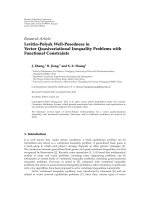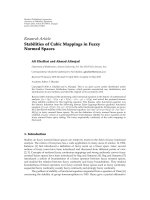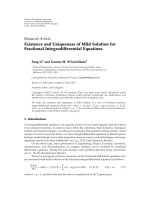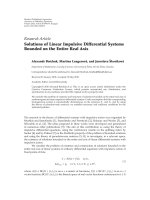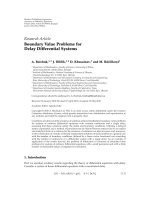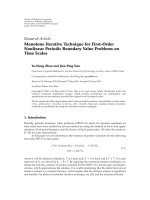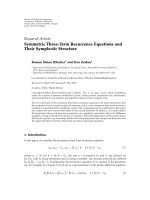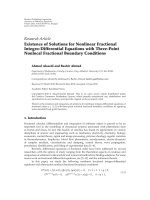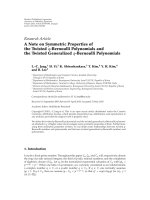Báo cáo sinh học: " Research Article Interactions between Uterine EMG at Different Sites Investigated Using Wavelet Analysis: Comparison of Pregnancy and Labor Contractions" pdf
Bạn đang xem bản rút gọn của tài liệu. Xem và tải ngay bản đầy đủ của tài liệu tại đây (1.77 MB, 9 trang )
Hindawi Publishing Corporation
EURASIP Journal on Advances in Signal Processing
Volume 2010, Article ID 918012, 9 pages
doi:10.1155/2010/918012
Research Article
Interactions between Uter i ne EMG at Different Sites
Investigated Using Wavelet Analysis: Comparison of
Pregnancy and Labor Contractions
Mahmoud Hassan,
1, 2
J
´
er
´
emy Terrien,
2
Brynjar Karlsson,
2, 3
and Catherine Marque
1
1
UMR CNRS 6600, Biom
´
ecanique et Bio-ing
´
enierie, Universit
´
edeTechnologiedeCompi
`
egne, 60200 Compi
`
egne, France
2
School of Science and Engineering, Reykjavik University, Menntavegur 1 101 Reykjavik, Iceland
3
Institute of Physiology, University of Iceland, Sæmundarg
¨
otu 2 101 Reykjavik, Iceland
Correspondence should be addressed to Mahmoud Hassan,
Received 30 December 2009; Revised 22 March 2010; Accepted 6 May 2010
Academic Editor: Aydin Akan
Copyright © 2010 Mahmoud Hassan et al. This is an open access article distributed under the Creative Commons Attribution
License, which permits unrestricted use, distribution, and reproduction in any medium, provided the original work is properly
cited.
This paper describes the use of the Morlet wavelet transform to investigate the difference in the time-frequency plane between
uterine EMG signals recorded simultaneously on two different sites on women’s abdomen, both during pregnancy and in labor.
The methods used are wavelet transform, cross wavelet transform, phase/amplitude correlation, and phase synchronization. We
computed the linear relationship and phase synchronization between uterine signals measured during the same contractions at
two different sites on data obtained from women during pregnancy and labor. The results show that the Morlet wavelet transform
can successfully analyze and quantify the relationship between uterine electrical activities at different sites and could be employed
to investigate the evolution of uterine contraction from pregnancy to labor.
1. Introduction
There are many open questions concerning the functioning
of the human uterus. One of these open questions concerns
exactly how the uterus operates as an organ to perform
the very organized act of contracting, in a synchronized
way, to expulse a new human into this world. If we do
not understand how the uterus works when it is working
normally, it is obvious that we will not be able to detect
or even prevent problems when it does not work properly
leading to child born before time, sometimes with tragic
consequences.
Uterine electromyography has been a research subject
for many years since the 1950s. It has been proven to
be of interest for pregnancy and parturition monitoring
[1–4].
Uterine electromyogram recorded externally in women,
the so-called electrohysterogram (EHG), has been proven to
be representative of uterine contractility. The analysis of this
signal may allow the prediction of a preterm labor threat as
soon as 28 weeks of gestation (WG) [5].
One of the ways used to understand the functioning
of biological systems is the detection of the relationship
between signals. Several methods are proposed; it can
be done by detecting the amplitude correlation (linear
and nonlinear regression ), or the frequency relation
(coherence ), or the phase synchronization and the depen-
dency in time-frequency domain.
There have been little studies in the past concerning
the application of these methods on EHG signals. One of
the most important work was Marque et al. who showed,
by using linear correlation coefficient, that the strongest
correlation between bursts is located at the low frequency
component [6]. The intercorrelation is however a temporal
method; it cannot be used to analyze the interplay of various
frequency components independently.
Furthermore, classical interrelation measures such as
Fourier-based coherence and correlation rely on the station-
arity of the measured signals, which is a condition that is
rarely fulfilled with real biological signals.
Time frequency distributions (TFDs) were introduced
as means of representing signals whose frequency content
2 EURASIP Journal on Advances in Signal Processing
is varying with time, and for which both time domain
representations and frequency domain representations are
inadequate to appropriately describe the signal. Many dif-
ferent TFDs of a signal exist, including, but not limited
to, the Wigner-Ville distribution (WVD), the spectrogram
using a Short Time Fourier Transform (STFT), the wavelet
transform (WT), the Hilbert Huang transform (HHT) and
other methods that evaluate several parameters with TFD,
such as the relationship between the instantaneous frequency
(IF) and the TFD’s [7]. Recently, alternative tools based
on wavelet analysis have been developed and successfully
applied to biological signals like EEG/MEG signals [8]. They
allow tracking the time course of coherence in nonstationary
neuronal signals with good temporal and frequency resolu-
tion.
Several approaches have been taken to study the relation-
ship between nonstationary signals in the time-frequency
domain. The three main approaches are
(1) multiple window time frequency analysis (MW-TFA)
[9],
(2) frequency-dependant correlation coefficient [10],
(3) time varying causal coherence function (TVCCF)
based on the multivariate autoregressive model [11].
We chose to use the complex-wavelet analysis because,
due to its variable window length, depending on the analyzed
frequency band, it does not suppose a particular model of
the data. Furthermore, another advantage is the possibility it
offers to extract phase information. In addition, the wavelet
analysis has been used with success on many types of signals
such as EEG signals [12]aswellasgeophysicaltimeseries
[13].
In a previous work, we have used the “wavelet coherence”
to detect the interaction between the uterine electrical
activities [14].
The results has shown the presence of higher coherence
at the low frequency with constant phase shift [15]. Another
interesting result is the possibility to use wavelet coherence
on the whole signal without segmentation of the bursts
of contractile activity [14]. However, the wavelet coherence
depends on both amplitude and phase of the time series.
Therefore, we cannot detect the nature of the relation by
using the wavelet coherence.
The aim of this work is to separate the two kinds of
information (phase and amplitude) in order to detect the
nature of the relation between the uterine bursts in the
time-frequency plane. First, we compute the scalogram of
two uterine bursts and get their cross-scalogram. We then
use two methods to describe phase and amplitude relation.
The first method is the wavelet local correlation coefficient
(WLCC), which detects the phase correlation. The second
one is the cross wavelet coherence function (CWCF), which
detects the amplitude correlation. The phase synchronization
is described by the wavelet synchronization index, which
can reveal the phase synchronization in the time-frequency
domain. This index is used to evidence a difference between
sets of uterine bursts during pregnancy and labor.
Table 1: Information on the segmentation of the bursts used in the
analysis.
pregnancy labor
Before burst 0–50 (s) 0–40 (s)
Burst 50–100 (s) 40–80 (s)
After burst 100–140 (s) 80–120 (s)
2. Materials And Methods
2.1. EHG Signals. The real EHG signals used in this study
are obtained from 10 women: 5 during pregnancy (30–32
week of gestation) and 5 women during labor. The measure-
ments were performed by using a 16-channel multipurpose
physiological signal recorder, most commonly used for
investigating sleep disorders (Embla A10). We used reusable
Ag/AgCl electrodes. The measurements were performed at
the Landspitali University hospital in Iceland, following a
protocol approved by the relevant ethical committee (VSN
02-0006-V2).
The signals used for this study were the bipolar signals
Vb7-Vb8 (Figure 1) corresponding to two channels on the
median vertical axis of the uterus. The signal sampling rate
was 200 Hz on 16 bits. The recording device has an anti-
aliasing filter with a low pass cutoff frequency of 100 Hz and
is capable of recording DC. The concurrent tocodynamome-
ter paper trace (tocographic trace) was digitized in order
to ease the identification of contractions. The EHG signals
were segmented manually to extract segments containing
uterine activity bursts. Tabl e 1 resumes the segmentation
information about the bursts shown in Figure 1.
2.2. Wavelet Analysis. The wavelet transform can be used
to analyze time series that contain nonstationary power for
many different frequencies [16].
The continuous wavelet transform (CWT) can decom-
pose a signal into a set of finite basis functions. Wavelet
coefficients W
X
(a, τ) are produced through the convolution
of a mother wavelet function Ψ(t) with the analyzed signal
X(t)or
W
X
(
a, τ
)
=
1
√
a
X
(
t
)
Ψ
∗
t −τ
a
dt,(1)
where a and τ denote the scale and translation parameters
respectively;
∗
denotes complex conjugation. By adjusting
the scale a,aseriesofdifferent frequency components in the
signal can be extracted. The
√
a is for energy normalization
across the different scales. The wavelet transforms, thus
projects the information of the time series X(t) on the two
dimension space (scale a and translation τ).
In this study, we used the complex Morlet wavelet, given
by
ψ
0
(
t
)
= π
−1/4
e
iω
0
t
e
−(1/2)t
2
,(2)
where ω
0
is the wavelet central pulsation. In this paper, we
used ω
0
= 2π. Morlet wavelet is a Gaussian–windowed
complex sinusoid; the Gaussian’s second order exponential
EURASIP Journal on Advances in Signal Processing 3
15
4
3
2
9
8
7
6
12
11
10
16
15
14
13
Ref Ref
Vb1
Vb2
Vb3
Vb4
Vb5
Vb6
Vb7
Vb8
Vb9
Vb10
Vb11
Vb12
(a)
−0.02
−0.015
−0.01
−0.005
0
0.005
0.01
0.015
0.02
0 20 40 60 80 100 120 140
Time (s)
Amplitude
(b)
−0.5
−0.4
−0.3
−0.2
−0.1
0
0.1
0.2
0.3
0.4
0.5
0 20 40 60 80 100 120
Time (s)
Amplitude
(c)
−0.02
−0.015
−0.01
−0.005
0
Amplitude
0.005
0.01
0.015
0.02
0204060
Time (s)
(b)
80 100 120 140
(d)
−0.4
−0.3
−0.2
−0.1
0
0.1
0.2
(c)
0.3
0 20 40 60 80 100 120
Time (s)
Amplitude
(e)
Figure 1: (a) Electrode configuration on the woman’s abdomen. Vbi represents the derived bipolar signals and ref. the reference electrodes.
(b) Two uterine bursts for the same contractions during pregnancy. (c) Two uterine bursts for the same contractions in labor. Both (b) and
(c) represent Vb7 (top) and Vb8 (bottom) bipolar signals.
4 EURASIP Journal on Advances in Signal Processing
decay of the Morlet function gives a good time localization
in the time domain [17]. We chose this wavelet as it pro-
vides simultaneously the signal amplitude and phase. This
property allows us to use the complex Morlet Wavelet trans-
form (cMWT) to investigate the coherence/synchronization
between two signals recorded at two different sites simulta-
neously.
Based on cMWT, the wavelet power of a time series X(t)
at the time scale space is called the scalogram. It is simply
defined as the squared modulus of W
X
(a, τ).
Given two time series X and Y, their cMWT are
W
X
(a, τ)andW
Y
(a, τ), respectively. Their cross-cMWT is
defined as W
XY
(a, τ) = W
X
(a, τ)W
∗
Y
(a, τ), where
∗
means
complex conjugation. The plot of
|W
XY
(a, τ)|
2
is called
cross-scalogram [12]. It provides the means to indicate the
coincident events over frequency, for each time in the signals
X and Y.
Cross-scalogram is a measure of the similarity of power,
at different frequency bands, for two separate uterine signals.
It gives a “direct” estimation of the correlation of two uterine
activities in the time–frequency domain. So the estimated
values contain bias and noise information. In preliminary
work [14], we used the wavelet coherence to describe the
relation between our signals in the time-frequency domain.
The wavelet coherence computes the relation in phase and
amplitude simultaneously. It does not permit to describe
separately the relations of amplitude and phase between two
uterine electrical activities. As we are interested in identifying
the nature of the relation between EHG signals, we choose to
use two different methods that focus on separate aspects of
the relationship between the signals, namely, the phase and
the amplitude.
(i) The first method is the Wavelet local correlation
coefficient (WLCC), proposed by [18]anddefinedas
WLCC
(
a, τ
)
=
Re
W
XY(a,τ)
|W
X
(
a, τ
)
||W
Y
(
a, τ
)
|
,(3)
whereReistherealpartofW
XY
. WLCC is a tool that
describes the phase correlation between two time series in
the time-frequency domain.
(ii) The second method is the cross wavelet coherence
function (CWCF) which computes the amplitude (intensity)
relation between two signals in the time-frequency domain
[19]. It is defined as
CWCF
(
a, τ
)
=
2
W
XY(a,τ)
2
|W
X
(a, τ)|
4
+ |W
Y
(a, τ)|
4
. (4)
The values of CWCF range between 0 (no amplitude
correlation between X and Y)and1(X and Y are totally
correlated in amplitude).
The application of these 2 methods on EEG signals
has indicated that phase correlation decreases during the
transition from interictal stage to ictal stage and that
amplitude correlation increases from interictal to ictal [12].
Simultaneously, with CWCF and WLCC, we computed
the phase difference between X and Y in the time-frequency
plane, defined as
φ
(
a, τ
)
= tan
−1
Re
(
W
XY
(
s, τ
))
Im
(
W
XY
(
s, τ
))
. (5)
Re is the real part of the cross-cMWT and Im is its
imaginary part.
The phase difference is represented by arrows with both
methods: WLCC and CWCF. Phase arrows indicate the phase
difference of the two bursts being compared. This can also
be interpreted as a lead/lag: if the arrows are oriented to the
right it means that the two signals are in phase and if they are
oriented to the left it means that the signals are in antiphase.
The parameter used for measuring phase synchroniza-
tion is the relative phase angle between two oscillatory
systems. The Morlet wavelet transform acts as a bandpass
filter and, at the same time, yields separate values for the
instantaneous amplitude A(t) and the phase Φ(t)ofatime
series signal at a specific frequency. Thus, the wavelet phases
of two signals X and Y can be used to determine their
instantaneous phase difference in a given frequency band,
and to establish a synchronization measure (Wavelet Phase
Synchronization: WPS) which quantifies the coupling of
phases independently from amplitude effects.
The principle of phase synchronization corresponds to a
phase locking between two systems defined as
ϕ
n,m
(
t
)
=|nΦ
X
(
t
)
−mΦ
Y
(
t
)
|≤C,(6)
where Φ
X
(t)andΦ
Y
(t) are the unwrapped phases of the
signals of the two systems and C is a constant. For real noisy
data the cyclic relative phase, ϕ
n,m
(t)mod 2π, is preferentially
used. Note that according to the above equation, the phase
difference has to be calculated from the univariate phase
angle. Phase locking is observed if the phase difference
remains approximately constant over some time period.
In order to evidence the variation of the strength of
phase synchronization between two uterine segment bursts,
we used the intensity of the first Fourier mode of the
distribution, given by
γ
n,m
(
t
)
=
cos
ϕ
n,m
(
t
)
2
+
sin
ϕ
n,m
(
t
)
2
,(7)
where
denotes the average over time. The measure of
synchronization strength range from 0 to 1. It is also called
the synchronization index. As it is the most usual case in
neurophysiological signals, in this paper we use m
= n = 1.
2.3. Statistical Test. The statistical significance of the results
of the two methods WLCC and CWCF was tested using
surrogates. By this way, we can be sure that the results
obtained are not due to chance and that they correspond to
real features present in the signals. Surrogate data are time
series that are generated in order to keep particular statistical
characteristics of an original time series while destroying all
others. They have been used to test for nonlinearity [20]
and nonstationarity of time series [21]. A classical approach
EURASIP Journal on Advances in Signal Processing 5
to construct such time series is phase randomization in
the Fourier domain or simulated annealing [20]. We used
the iterative amplitude adjusted Fourier transform (IAAFT)
method to produce the surrogates in the case of WLCC and
bootstraps in the case of CWCF. The choice of the type of
surrogates depends on the way the surrogate is resampled in
the particular method. We used the bootstraps in the case
of CWCF (linear relation) because its resampling is linear,
whereas when studying the phase correlation (nonlinear
relation) nonlinear resampling is needed and IAAFT is
appropriate in this case. In IAAFT, surrogates have the same
power spectrum and autocorrelation function as the original
time series, but their phases are totally different.
The method we propose to use in this work can be
described with the following steps, for WLCC, for example,
(1) compute WLCC between the two original signals X
and Y,weobtainWLCCorg,
(2) generate N surrogates from signal Y, so we obtained:
Y
s
(s = 1 N),
(3) at each surrogate, calculate WLCC between X and Y
s
then: WLCCsurr = WLCC(X, Ys),
(4) the confidence limit for WLCC may be obtained from
the tails of the WLCCsurr distribution,
(5) the generated surrogates have the same amplitude
information as Y but their phases are randomized.
The null hypothesis is that the results related to
amplitude information obtained on Y are the same
as those obtained on the surrogates. By rejecting this
hypothesis we can be sure (to within 1-p) that the
phase information obtained is significant and not due
to chance,
(6) “rank test” is used to reject or accept the hypothesis.
In a rank test, [WLCCorg; WLCCsurr (:)] is sorted in
increasing order, and the rank index for WLCCorg returned.
With a number of surrogates (n
surr = 25 for example), if
the rank of WLCCorg is unity or 25, this means that it lies in
the tail of the distribution, and the null can be rejected (two-
tailed test) with a significance of p
= 2
∗
(1/(n surr + 1)).
In this paper, the n
surr used was 100. Ranks <5and> 95
were considered significant and the hypothesis thus rejected
(P
= .05). The significant values were contoured by thick
black lines and arrows are only plotted inside the contoured
regions but values that did not test as significant were not
plotted on the graphs.
3. Results
As stated before, wavelet transform is a powerful tool
to analyze non-stationary signals [12]. In this section we
present the results of applying this powerful tool to analyze
the relationship between uterine signals recorded at different
sites during the same contractions. All the results were
obtained using MATLAB (version 2008b) on a Pentium4
(2 GHz) PC computer. The typical computational costs are
0.12 ms per contraction for scalogram, cross-scalogram and
phase synchronization, and 10 min per contraction for
WLCC and CWCF with the significance test.
The scalogram displays the frequency content of the
EHG signal over time. The difference in its aspect between
pregnancy and labor bursts is clear and as shown in Figure 2:
in labor (Figures 2(a) and 2(b) right) there are more high-
frequency components than during pregnancy (Figures 2(a)
and 2(b) left).
In Figure 2 and Figure 3,twoEHGdatasetsareused:
Vb7 (denoted by X) and Vb8 (denoted by Y). Their
MWT are W
X
(a, τ)andW
Y
(a, τ), respectively. The plot
of
|W
XY
(a, τ)|
2
displays the coincident events in the time-
frequency domain for the two EHG signals: Figure 2(c)
(left) shows the cross-scalogram of the two bursts measured
during pregnancy; Figure 2(c) (right) shows the cross-
scalogram of the two bursts measured during labor.
The cross-scalogram shows that the highest levels of
common power are located during the uterine activity that is,
50s–100s for the pregnancy bursts and 40s–80s for the labor
bursts. This common power is therefore clearly due to and
related to the contractile activity of the uterus.
Based on Figure 1, the uterine electrical activities occur
between 40–100 s for the pregnancy bursts and 40–80 s for
the labor bursts (segmented from the Tocographic trace).
The statistical rank test with surrogates is applied to
the CWCF and WLCC methods. When the statistical test
indicates that the values obtained are significant, the area
where these values are located are contoured by a thick
black line and any values obtained outside these regions
(nonsignificant) are shown as blank. The arrows indicating
the phase difference are plotted only inside the regions where
the values are found to be significant.
In the case of the signals recorded during pregnancy,
we notice a small area between 40 s and 100 s where the
method shows significant values in the case of CWCF-
amplitude correlation—(Figure 3(a))andmuchlargerarea
in the case of WLCC-phase correlation—(Figure 3(c)). In the
labor contraction we notice the opposite (between 40 s and
80 s): large areas of significance with CWCF and smaller ones
with WLCC.
The comparison between CWCF and WLCC figures indi-
cates that during pregnancy there is more phase correlation
than during labor. At the opposite, there is more amplitude
correlation during labor than during pregnancy (Figure 3).
Some regions of significance can be seen outside the burst
ranges that are probably due to noise. This is one of the
disadvantages of both methods. The use of wavelet coherence
that has great advantages is better in this respect because
it can be applied to the whole signal without segmen ta-
tion.
The results of CWCF are similar to our previous results,
with a method that computes the nonlinear amplitude
relation between two signals in the time domain, that
indicated an increase in the nonlinear correlation coefficient
from pregnancy to labor [22].
Concerning the wavelet phase synchronization results,
Figure 4 indicates, either during labor or pregnancy, the
highest phase synchronization is located at the lower
frequencies of the signal. The phase synchronization is higher
6 EURASIP Journal on Advances in Signal Processing
0
0.1
0.2
0.3
0.4
0.5
0.6
0.7
0.8
0.9
1
0 20 40 60 80 100 120
Time (s)
Scalogram
Frequency (Hz)
0
0.1
0.2
0.3
0.4
0.5
0.6
0.7
0.8
0.9
1
020406080
Time (s)
Scalogram
Frequency (Hz)
100
1
2
3
4
5
6
7
8
9
×10
−6
0.02
0.04
0.06
0.08
0.1
0.12
0.14
0.16
0.18
(a)
0
0.1
0.2
0.3
0.4
0.5
0.6
0.7
0.8
0.9
1
0 20 40 60 80 100 120
Time (s)
Scalogram
Frequency (Hz)
0
0.1
0.2
0.3
0.4
0.5
0.6
0.7
0.8
0.9
1
020406080
Time (s)
Scalogram
Frequency (Hz)
100
0.5
1
1.5
2
2.5
3
3.5
4
×10
−6
0.01
0.02
0.03
0.04
0.05
0.06
0.07
0.08
0.09
(b)
0
0.1
0.2
0.3
0.4
0.5
0.6
0.7
0.8
0.9
1
0 20 40 60 80 100 120
Time (s)
Cross-scalogram
Frequency (Hz)
0
0.1
0.2
0.3
0.4
0.5
0.6
0.7
0.8
0.9
1
020406080
Time (s)
Cross-scalogram
Frequency (Hz)
100
0.5
1
1.5
2
2.5
3
3.5
×10
−3
4
×10
−11
2
4
6
8
10
12
14
16
(c)
Figure 2: (a) and (b) Scalogram for the two bursts and (c) Cross-scalogram between the two bursts. (Left) pregnancy, (Right) labor.
during pregnancy than during labor, which confirms the
results of WLCC presented in Figure 3.
Inordertocomparequantitativelybetweenpregnancy
and labor, the signals were numerically filtered in three
frequency bands (0–0.25 Hz; 0.25–0.5 Hz; >0.5 Hz). Then
the mean of WPS was computed for each band. By doing
this, we aim to evidence for which frequency bands the
highest phase synchronization is located. Our previous work
indicated that the highest coherence (computed by wavelet
coherence) was located at the lower frequencies [14]. We seek
to confirm this result. The second aim of this analysis is to
investigate the difference in phase synchronization (WPS)
between pregnancy and labor bursts in order to find if this
method can potentially be used as a tool to classify pregnancy
versus labor EHG bursts.
The results in Ta ble 2 correspond to the mean of WPS
at different frequency bands calculated on 25 contractions
(CTs) for 5 women during pregnancy (30 to 36 WG) and 25
contractions from 5 women during labor (delivery time of
39 to 42 WG). These results indicate that the highest phase
EURASIP Journal on Advances in Signal Processing 7
0
0.1
0.2
0.3
0.4
0.5
0.6
0.7
0.8
0.9
1
0 20 40 60 80 100 120
Time (s)
CWCF (amplitude correlation)
Frequency (Hz)
0
0.1
0.2
0.3
0.4
0.5
0.6
0.7
0.8
0.9
1
(a)
0
0.1
0.2
0.3
0.4
0.5
0.6
0.7
0.8
0.9
1
0 20406080100
Time (s)
CWCF (amplitude correlation)
Frequency (Hz)
0
0.1
0.2
0.3
0.4
0.5
0.6
0.7
0.8
0.9
1
(b)
0
0.1
0.2
0.3
0.4
0.5
0.6
0.7
0.8
0.9
1
0 20 40 60 80 100 120
Time (s)
WLCC (phase correlation)
Frequency (Hz)
−1
−0.8
−0.6
−0.4
−0.2
0
0.2
0.4
0.6
0.8
1
(c)
0
0.1
0.2
0.3
0.4
0.5
0.6
0.7
0.8
0.9
1
0 20406080100
Time (s)
WLCC (phase correlation)
Frequency (Hz)
−1
−0.8
−0.6
−0.4
−0.2
0
0.2
0.4
0.6
0.8
1
(d)
Figure 3: (a)-(b) Cross wavelet coherence function: amplitude correlation between two bursts. (c)-(d) Wavelet local correlation: phase
correlation between two bursts. (Left): pregnancy, (right): labor. The vertical lines indicate the start and the end of the uterine activity
extracted from the Topography trace. Inside the thick black line there is significant level of 95% with resampling of Bootstraps (CWCF) and
IAFFT (WLCC). The phase difference of cross spectrum is shown by arrow direction (in-phase: arrow pointing right, means Vb7 leads Vb8;
antiphase: arrow pointing left, means Vb8 leads Vb7).
Table 2: Comparison between mean (
± standard deviation) of
WPS at different frequency bands for 25 pregnancy bursts and 25
labor bursts.
Pregnancy Labor
0 < f(Hz) ≤0.25 0.59 ± 0.05 0.57 ± 0.06
0.25 < f(Hz)
≤ 0.5 0.53 ± 0.07 0.48 ± 0.06
f(Hz) > 0.5 0.49
± 0.05 0.46 ± 0.02
synchronization during both pregnancy and during labor is
at the low frequencies (0–0.25 Hz) and the results indicate
a significance difference (P
= .05) in the phase synchroniza-
tion in the time-frequency plane between pregnancy and
labor.
The values indicate also that during labor the location
of the high synchronization becomes clearer and that there
is more difference between values at the low frequencies
and higher ones, while this difference is less clear during
pregnancy.
4. Discussion and Conclusion
In this paper, a study based on the Morlet wavelet transform
is proposed to analyze the difference between uterine electri-
cal activity bursts recorded from woman during pregnancy
and others from women during labor. The wavelet trans-
form, cross wavelet transform, phase correlation, amplitude
correlation, and phase synchronization of the two types of
uterine signals were described.
The scalogram exhibited the previously observed result:
the presence of higher frequency components during labor
than during pregnancy.
The cross-scalogram was used to detect where the
highest common power was located between the two signals
recorded during the same contraction. The highest common
powers were found to be at lower frequencies during
pregnancy than during labor.
WLCC and CWCF are two tools used to separate the
phase and amplitude correlation. We used them in order
to detect the nature of the relation between signals, for
pregnancy and labor. The results indicate that there is
8 EURASIP Journal on Advances in Signal Processing
−0.02
−0.015
−0.01
−0.005
0
0.005
0.01
0.015
0.02
0 20 40 60 80 100 120 140
Time (s)
Amplitude
Vb7
Vb8
(a)
−0.5
−0.4
−0.3
−0.2
−0.1
0
0.1
0.2
0.3
0.4
0.5
0 20 40 60 80 100 120
Time (s)
Amplitude
Vb7
Vb8
(b)
0
0.1
0.2
0.3
0.4
0.5
0.6
0.7
0.8
0.9
1
0 20 40 60 80 100 120
Time (s)
Wavelet phase synchronization
Frequency (Hz)
0
0.1
0.2
0.3
0.4
0.5
0.6
0.7
0.8
0.9
1
(c)
0
0.1
0.2
0.3
0.4
0.5
0.6
0.7
0.8
0.9
1
0 20 40 60 80 100 120
Time (s)
Wavelet phase synchronization
Frequency (Hz)
0
0.1
0.2
0.3
0.4
0.5
0.6
0.7
0.8
0.9
1
(d)
0.35
0.4
0.45
0.5
0.55
0.6
0.65
0.7
0.75
0.8
0.85
00.10.20.30.40.50.60.70.80.91
Frequency (Hz)
Mean WPS
(e)
0.4
0.5
0.6
0.7
0.8
0.9
1
00.10.20.30.40.50.60.70.80.91
Frequency (Hz)
Mean WPS
(f)
Figure 4: The phase synchronization between the two uterine bursts: pregnancy (left) and labor (right).
more significant amplitude correlation in labor than during
pregnancy and more significant phase correlation during
pregnancy than in labor.
Phase synchronization index in the time frequency
domain, is then used to describe the phase synchronization
between signals. The pregnancy signals were again shown to
be more synchronized in phase than the labor signals.
We noted that the results of WLCC and CWCF are similar
with the results of the EEG during the transition from preic-
tal to ictal stages, a phase desynchronization and amplitude
synchronization. The question can be raised if there are
similarities in the underlying physiological interpretation of
these phenomena.
Although the cross-scalogram, WLCC, CWCF, and
wavelet phase synchronization can describe linear relation-
ship between the two time series, nonlinear interactions
between the two time series cannot be revealed by these
methods. The next step will be the use of the bicoherence
method, which is a powerful tool to detect the nonlinear
relation between signals.
EURASIP Journal on Advances in Signal Processing 9
We also plan to use signals recorded during pregnancy
and labor for the same woman. By studying the time-
frequency synchronization longitudinally along the weeks
of gestation, we expect to be able to define the parameters
related to propagation that are most likely to evidence the
change from the no-coherent and inefficient contractions,
during normal pregnancy, to the strong and organized
contractions of labor. If robust parameters of this type can be
found, these methods can be used to predict preterm labor.
Acknowledgments
This paper is financed by the Icelandic centre for research
RANN
´
IS and the French National Center for University and
School (CNOUS). The authors would like to especially thank
Mr.
´
Asgeir Alexandersson for his help in the acquisition of
EHG signals.
References
[1] G. M. Wolfs and M. van Leeuwen, “Electromyographic obser-
vations on the human uterus during labour,” Acta Obstetricia
et Gynecologica Scandinavica, vol. 58, supplement 90, pp. 1–61,
1979.
[2] C.M.SteerandG.J.Hertsch,“Electricalactivityofthehuman
uterus in labor; the electrohysterograph,” American Journal of
Obstetrics and Gynecology, vol. 59, no. 1, pp. 25–40, 1950.
[3] J. G. Planes, J. P. Morucci, H. Grandjean, and R. Favretto,
“External recording and processing of fast electrical activity
of the uterus in human parturition,” Medical and Biological
Engineering and Computing, vol. 22, no. 6, pp. 585–591, 1984.
[4] C. Marque, J. M. G. Duchene, S. Leclercq, G. S. Panczer,
and J. Chaumont, “Uterine EHG processing for obstetrical
monitoring,” IEEE Transactions on Biomedical Engineering,
vol. 33, no. 12, pp. 1182–1187, 1986.
[5] H. L
´
eman, C. Marque, and J. Gondry, “Use of the electro-
hysterogram signal for characterization of contractions during
pregnancy,” IEEE Transactions on Biomedical Engineering, vol.
46, no. 10, pp. 1222–1229, 1999.
[6] C. Marque and J. Duchene, “Human abdominal EHG process-
ing for uterine contraction monitoring,” in Applied Biosens ors,
pp. 187–226, Butterworth, Boston, Mass, USA, 1989.
[7] B. Boashash, “Interpreting and estimating the instantaneous
frequency of a signal-part 1: fundamentals,” Proceedings of the
IEEE, vol. 80, pp. 520–538, 1992.
[8] J P. Lachaux, A. Lutz, D. Rudrauf et al., “Estimating the
time-course of coherence between single-trial brain signals: an
introduction to wavelet coherence,” Neurophysiologie Clinique,
vol. 32, no. 3, pp. 157–174, 2002.
[9] Y. Xu, S. Haykin, and R. J. Racine, “Multiple window time-
frequency distribution and coherence of EEG using Slepian
sequences and Hermite functions,” IEEE Transactions on
Biomedical Engineering, vol. 46, no. 7, pp. 861–866, 1999.
[10] K. Ansari-Asl, J J. Bellanger, F. Bartolomei, F. Wendling, and
L. Senhadji, “Time-frequency characterization of interdepen-
dencies in nonstationary signals: application to epileptic EEG,”
IEEE Transactions on Biomedical Engineering,vol.52,no.7,pp.
1218–1226, 2006.
[11] H. Zhao, W. A. Cupples, K. H. Ju, and K. H. Chon, “Time-
varying causal coherence function and its application to renal
blood pressure and blood flow data,” IEEE Transactions on
Biomedical Engineering, vol. 54, no. 12, pp. 2142–2150, 2007.
[12] X. Li, X. Yao, J. Fox, and J. G. Jefferys, “Interaction dynamics
of neuronal oscillations analysed using wavelet transforms,”
Journal of Neuroscience Methods, vol. 160, no. 1, pp. 178–185,
2007.
[13] A. Grinsted, J. C. Moore, and S. Jevrejeva, “Application of the
cross wavelet transform and wavelet coherence to geophysical
times series,” Nonlinear Processes in Geophysics, vol. 11, no. 5-6,
pp. 561–566, 2004.
[14] M. Hassan, J. Terrien, B. Karlsson, and C. Marque, “Applica-
tion of wavelet coherence to the detection of uterine electrical
activity synchronization in labor,” IRBM,vol.31,no.3,pp.
182–187, 2010.
[15] M. Hassan, J. Terrien, B. Karlsson, and C. Marque, “Coherence
and phase relationship analysis of the two main frequency
components of EHG, as observed by complex wavelet trans-
form,” in Proceedings of the World Congress on Medical Physics
and Biomedical Engineering, vol. 25, no. 4, pp. 2219–2222,
Munich, Germany, September 2009.
[16] I. Daubechies, “Wavelet transform, time-frequency localiza-
tion and signal analysis,” IEEE Transactions on Information
Theory, vol. 36, no. 5, pp. 961–1004, 1990.
[17]C.TorrenceandG.P.Compo,“Apracticalguidetowavelet
analysis,” Bulletin of the American Meteorological Society, vol.
79, no. 1, pp. 61–78, 1998.
[18] L. G. Buresti and G. Lombardi, “Application of continuous
wavelet transforms to the analysis of experimental turbulent
velocity signals,” in Proceedings of the 1st International Sympo-
sium on Turbulence and Shear Flow Phenomena
, vol. 1, p. 762,
Begell House, Santa Barbara, Calif, USA, 1999.
[19] S. Sello and J. Bellazzini, “Wavelet cross-correlation anal-
ysis of turbulent mixing from large-eddy-simulations,”
/>[20] T. Schreiber and A. Schmitz, “Surrogate time series,” Physica
D, vol. 142, no. 3-4, pp. 346–382, 2000.
[21] P. Borgnat and P. Flandrin, “Stationarization via surrogates,”
Journal of Statistical Mechanics: Theory and Exp eriment, vol.
2009, no. 1, Article ID P01001, 2009.
[22] M. Hassan, J. Terrien, B. Karlsson, and C. Marque, “Spatial
analysis of uterine EMG signals: evidence of increased in
synchronization with term,” in Proceedings of the IEEE Annual
International Conference of the Engineering in Medicine and
Biology Society (EMBC ’09), vol. 1, pp. 6296–6299, 2009.

